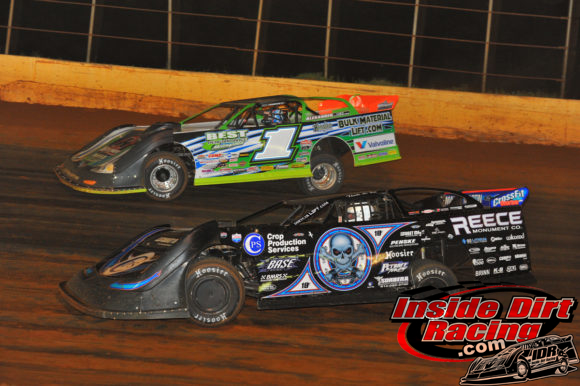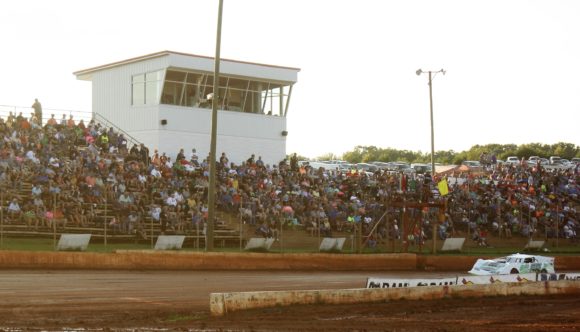Over the past five years I have averaged covering just over fifty races per season. The tracks I have visited are spread out over a broad range across the southeastern United States from Virginia, Kentucky, Tennessee, Georgia and both Carolinas. Seeing so many races in so many places has allowed me to observe a number of different promoting styles leading up to the race day in question as well as a number ways of actually running the racing program itself.
One thing that I have grown to be a big advocate of is the running of the primary feature race somewhere other than last on the night’s schedule of events. For example, if there are four classes competing that night, the race that was most advertised as the main event should not be the fourth feature to roll onto the track.
I have a number of reasons for supporting this premise. And please keep in mind that these points are not directed at any one particular track because, as I said earlier, I go to many different venues and see many different formats. The things I am going to mention below have probably happened at some point or another to just about every race track in existence … and many that are no long in existence.
Here is my list of reasons for running the primary feature somewhere other than last on the agenda:
Fans who travel long distances to the track: Any race fan who has driven two or three hours to get to the facility in question does not want to feel as if he/she is trapped and cannot leave until 1:00am and thus not get back home until it is almost time for the sun to rise the next morning. Fans who find themselves in this position will be reluctant to return to that track the next time they see a big race advertised. Instead, they will go to a speedway closer to their home or simply not go anywhere.
Having the primary feature race run in the second or third spot out of four or five features gives this fan the option of staying to watch more racing on a night in which the show has run smoothly or leaving at the end of the bigger race if things have dragged out a bit. And most importantly, it will cause this fan to feel like it is worth the effort to occasionally attend a race further from his/her home.
Plan for the unexpected: The phrase “what can go wrong will go wrong” seems to have been thought up with dirt racing in mind. One particular feature that turns into a caution-fest, the lights suddenly going out, a car getting flipped over and taking a long time to get turned right side up, a problem with the retaining wall or catch fence, a medical emergency in the grandstand or on the track that takes time to resolve, a problem with the track itself, the scoring system malfunctioning, and countless other catastrophes are some of the issues that we have all seen at one time or another.
No one plans for any of these issues to occur, but one or the other seemingly always does. With that in mind, a track promoter could be putting the biggest race of the night in jeopardy of running up against a curfew or taking so long to get to that fans start to leave before it ever takes the green flag. And if that happens, those fans who could not stay for the main event are not going to go on social media or offer word of mouth to their friends of what a great experience they had at the track. Instead they are going to complain of being ripped off, and everyone knows that is not good for business.
And another point this raises is the need for the track and the series to be flexible. If some of these unexpected issues arise, be willing to move the main feature of the night up in the program to address the problem.
Fans who brought kids: The sport of dirt racing desperately needs a younger audience to fill the void that will inevitably come when the current generation of fans is no longer around. When children are young, they may have little choice in regard to coming to the track with parents or grandparents. But there will come a day when they get old enough to make their own entertainment decisions and if they were made to feel as if they were trapped at a race track for longer than they wanted to be as children, they will not come back as adults.
Those fans who bring kids to the track need to have the option to take their tired and restless youngsters home and still see the race they came for. If the feature race they paid $25/each to attend hasn’t run yet, they will feel as if they are trapped as well and may decide that it is much easier on a Friday or Saturday night to go to a Disney movie that has a definite ending time than to go to a race track that has a fluid ending time that trends toward too late.
Weather concerns: It seems as if the biggest determinant of whether a race night will run to its conclusion or run at all is the weather. Rain, snow, excessive heat, excessive cold and whatever else Mother Nature opts to throw our way can interrupt the best laid plans of promoters, racers and fans.
Few things could be worse for a track’s reputation than to know weather is coming(and with smart phones we all know when it’s coming) and have the main event get rained out after having run other classes earlier in the night. Also, having fans sit out in cold temperatures during a long night will not help a track’s standing with its paying customers. Fans will not be shy about claiming that they were cheated by the promoters after having paid special event prices only to not see the special event.
Further, losing a feature to weather that could have been run earlier in the night creates the headache of trying to reschedule and having to refund money to fans or issue a suitable rain check. It’s much easier to tell one of your weekly classes that you will make it up to them with a double feature the next week than trying to reschedule a traveling series event. So if weather is coming, get that special event in before the rain comes.
Helps with traffic control: A travelling series event is more than likely going to put more fans in the grandstand than a regular, weekly show. That also means there will be more cars in the parking lot as well. Running the primary feature last means that everyone who attended that night will be leaving the facility at the same time. Running the primary feature somewhere other than last means that those who traveled from further away have the option to leave early while those who may be fans of the weekly divisions can stay to cheer on their favorites. As a result, all those cars in the parking lot will be leaving at different times and not creating long lines to get out and frustration that will manifest itself on social media or elsewhere.

Travelling series racers like Scott Bloomquist(0) and Josh Richards need to move on to their next race
Lets travelling series racers move on to their next race: Some of the touring series have it written into their contracts with the host tracks that their series cannot be the last feature of the night. This allows their teams to get packed up and headed on to the next race as quickly as possible. But even if there is no such contractual obligation, the track should use this approach anyway.
One reason for doing so is to create a positive mindset for those racers about that track. The better they feel about a particular facility when their series races there, the more likely they are to return when they have an opportunity to race at that venue under a different series banner. That means better car counts across the board which means more fans are likely to show up for the races that cost the promoter the most money to conduct.
The electric atmosphere can wear off: One problem that can arise from putting the primary feature off for too long into the night is that the electricity surrounding that race can get dialed down as fans face their fourth or fifth hour of confinement to an uncomfortable wooden or concrete seat in a crowded grandstand. Few things can be more exciting than having a feature race roll onto the track in front of a charged up audience. But if they are tired and irritable, the folks in that audience are less likely to be charged up come feature time.
So there is my list. You may agree with all, some, or none of the points mentioned. But I believe from my experience at covering races it is best not to schedule the primary feature race of the night in the last position on the race lineup because of the reasons I have listed above.
Yes, I understand that weekly racers have needs as well, but for the most part, they are close to home when at their regular track. And keep in mind that this list applies to weekly races as much as touring series special events. If Limited Late Models is the track’s top division, that race should not be the last to run on a weekly night. But the fans have to be given the most consideration. Without the fans, there are no races to race in. And the better the mindset of the fans, the longer this sport will live and prosper.
I know there is a case for dragging the show out to sell more hot dogs but that should never outweigh making sure fans have a good experience at the track because you will never sell a hot dog to someone who refuses to come back to your track after having had a bad experience.
This sport often gets too caught up in “That’s the way we’ve always done it” for its own good. I am a history teacher and I love tradition as much as anybody, but that’s only if the tradition is a beneficial one. Whether we like it or not, the world is changing and dirt racing needs to stay in tune with that change. This sport has some serious financial issues looming. The number of tracks that close down and the number of racers who give up each year demonstrate that.
Keeping shows moving along and providing good experiences for the fans is a must in a world with so many entertainment options.
To interact with us on social media, follow @RichardAllenIDR & @MichaelRMoats on Twitter or Like our Facebook page.






